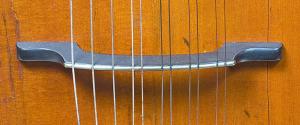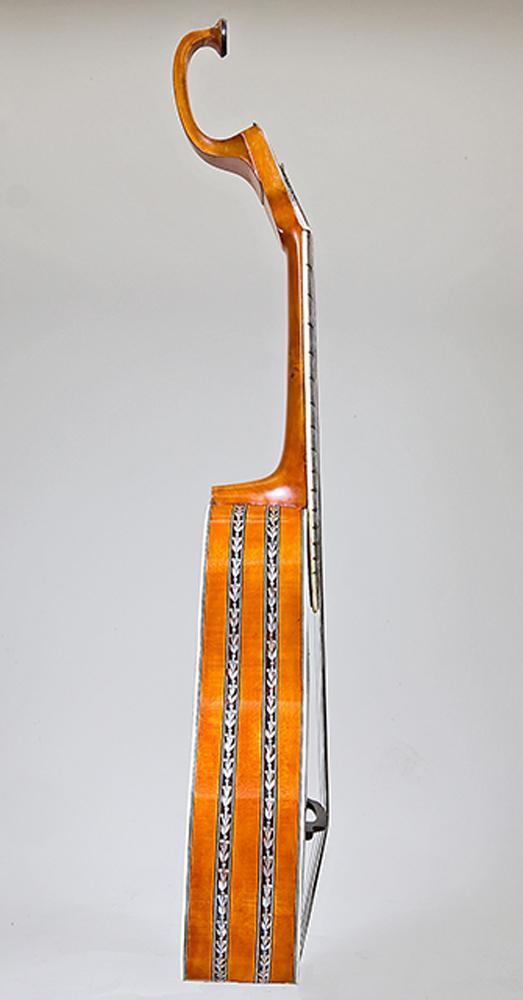Home
>
Works
>
Guitare allemande
>
Advanced Search
Plucked Strings
Citterns and English Guitars
Guitare allemande
Alternate name:Cittern
Maker: Gérard Deleplanque
Date: 1777
Place Made:Lille, France, Europe
Serial No: none
SignedPrinted on paper label with decorative border, the last two digits of year written in black ink: GÉRARDJ. DELEPLANQUE, / Luthier, ruedela Grande- / Chauflée, conindecelledes / Dominicains, à Lille. 1777
DescriptionThe guitare allemande or cistre was a wire-strung instrument of France influenced by similar German and English types of the period. Deleplanque made both wire-strung cittern and gut-strung guitar-type instruments.
Stringing: seven steel and brass double courses, the upper four double and the bottom three single
Soundboard: two-piece, quarter-cut spruce, narrow-grain broadening to medium at the sides
Back: two-piece quarter-cut maple with faint, broad curl, divided into eight sections by mother-of-pearl floral inlay set into imitation-tortoise-shell mastic, surrounded on each side by two-ply bone and ebony strips; back button set in from profile of back with mother-of-pearl diamond inlay arranged in half star shape, set in imitation tortoise-shell mastic enclosed in mother-of-pearl half ring
Ribs: plain quarter-cut maple divided into three sections by longitudinal mother-of-pearl floral inlay set into imitation-tortoise-shell mastic, surrounded on each side by two-ply bone and ebony strips; divided by same at end button
Head and neck: plain maple with several knots; head above machine tuners separate piece head terminates in circle with mother-of-pearl diamond inlay arranged in star shape, set in imitation tortoise-shell mastic enclosed in mother-of-pearl ring; front of head below tuner with similar inlay plus mother-of-pearl dots, and this inlay and tuners surrounded by mother-of-pearl binding
Binding and purfling: ivory with mother-of-pearl floral inlay set into imitation-tortoise-shell mastic, surrounded on each side by two-ply bone and ebony strips on top and back, and ebony and bone purfling on sides
Fingerboard: spruce covered with floral mother-of-pearl inlay set into imitation tortoish-shell mastic, with bone and ebony purfling and ivory binding; undercut, incurved fingerboard end; 15 steel bar frets
Nut: bone
Bridge: ebony with nickel-silver saddle; later
Tuner: single silver-plated brass watch key mechanism
Saddle: bone; top wider than bottom
Endpins: 9 bone; 2 later ivory
Strap button: bone on lower rib; neck heel strap button missing (hole remains)
Rose: maple with black-stained edges overlaid with mother-of-pearl
Rosette: three rings of mother-of-pearl floral inlay set into imitation-tortoise-shell mastic, surrounded on each side by three ply bone and ebony strips, 7-ply bone and ebony on innermost edge
Varnish: light orange
Linings: light hardwood; wide
Back braces: 3 or more spruce ladder braces; 24 spruce cleats along center line
Stringing: seven steel and brass double courses, the upper four double and the bottom three single
Soundboard: two-piece, quarter-cut spruce, narrow-grain broadening to medium at the sides
Back: two-piece quarter-cut maple with faint, broad curl, divided into eight sections by mother-of-pearl floral inlay set into imitation-tortoise-shell mastic, surrounded on each side by two-ply bone and ebony strips; back button set in from profile of back with mother-of-pearl diamond inlay arranged in half star shape, set in imitation tortoise-shell mastic enclosed in mother-of-pearl half ring
Ribs: plain quarter-cut maple divided into three sections by longitudinal mother-of-pearl floral inlay set into imitation-tortoise-shell mastic, surrounded on each side by two-ply bone and ebony strips; divided by same at end button
Head and neck: plain maple with several knots; head above machine tuners separate piece head terminates in circle with mother-of-pearl diamond inlay arranged in star shape, set in imitation tortoise-shell mastic enclosed in mother-of-pearl ring; front of head below tuner with similar inlay plus mother-of-pearl dots, and this inlay and tuners surrounded by mother-of-pearl binding
Binding and purfling: ivory with mother-of-pearl floral inlay set into imitation-tortoise-shell mastic, surrounded on each side by two-ply bone and ebony strips on top and back, and ebony and bone purfling on sides
Fingerboard: spruce covered with floral mother-of-pearl inlay set into imitation tortoish-shell mastic, with bone and ebony purfling and ivory binding; undercut, incurved fingerboard end; 15 steel bar frets
Nut: bone
Bridge: ebony with nickel-silver saddle; later
Tuner: single silver-plated brass watch key mechanism
Saddle: bone; top wider than bottom
Endpins: 9 bone; 2 later ivory
Strap button: bone on lower rib; neck heel strap button missing (hole remains)
Rose: maple with black-stained edges overlaid with mother-of-pearl
Rosette: three rings of mother-of-pearl floral inlay set into imitation-tortoise-shell mastic, surrounded on each side by three ply bone and ebony strips, 7-ply bone and ebony on innermost edge
Varnish: light orange
Linings: light hardwood; wide
Back braces: 3 or more spruce ladder braces; 24 spruce cleats along center line
DimensionsTotal guitare allemande length: 772 mm
Back length: 370 mm
Back width, upper bout: 166 mm
Back width, lower bout: 177 mm
Back width, lower bout: 314 mm
Rib height (including edging) at heel: 79mm
Rib height, at waist: 82 mm
Rib height, at end block: 91 mm
Head and pegbox length: 191 mm
Head width, top: 29 mm
Pegbox width, bottom: 69 mm
Neck length (nut to ribs): 223 mm
Neck width, nut: 54 mm
Neck width, heel: 64 mm
Soundhole diameter: 72 mm
Vibrating string length (nut to bridge): 476 mm
Back length: 370 mm
Back width, upper bout: 166 mm
Back width, lower bout: 177 mm
Back width, lower bout: 314 mm
Rib height (including edging) at heel: 79mm
Rib height, at waist: 82 mm
Rib height, at end block: 91 mm
Head and pegbox length: 191 mm
Head width, top: 29 mm
Pegbox width, bottom: 69 mm
Neck length (nut to ribs): 223 mm
Neck width, nut: 54 mm
Neck width, heel: 64 mm
Soundhole diameter: 72 mm
Vibrating string length (nut to bridge): 476 mm
ProvenanceLaurence Witten acquired from the collection of Lord Astor at Hever Castle, acquired at Christie's, 12 Nov. 1963, Lot 8.
Purchased by the National Music Museum from Laurence Witten Family, New Haven, Connecticut, 1984.
Purchased by the National Music Museum from Laurence Witten Family, New Haven, Connecticut, 1984.
Terms
Credit Line: Witten-Rawlins Collection, 1984
Not on view
Published References"Black Hills Exhibit Features Mozart and 18th-Century Vienna," Shrine to Music Museum Newsletter XVII, no. 2 (January 1990), p. 8.
James Westbrook and Ted Fuller, The Complete Illustrated Book of the Acoustic Guitar (Wigston, UK: Lorenz Books, 2012), p. 249.
Inventing the American Guitar : the Pre-Civil War Innovations of C.F. Martin and His Contemporaries. Edited by Robert Shaw and Peter Szego (Milwaukee: Hal Leonard Books, 2013), p. 23.
James Westbrook and Ted Fuller, The Complete Illustrated Book of the Acoustic Guitar (Wigston, UK: Lorenz Books, 2012), p. 249.
Inventing the American Guitar : the Pre-Civil War Innovations of C.F. Martin and His Contemporaries. Edited by Robert Shaw and Peter Szego (Milwaukee: Hal Leonard Books, 2013), p. 23.
Object number: 03440


























